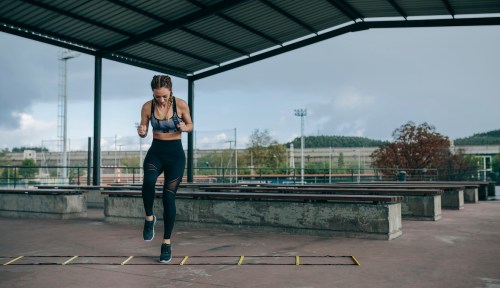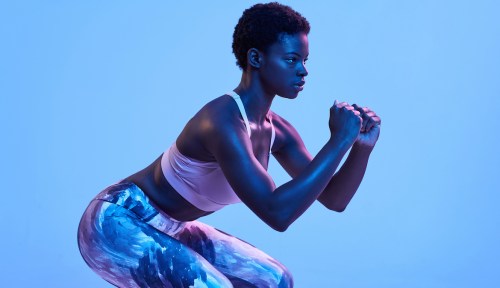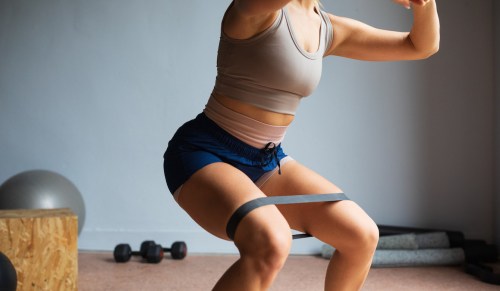Thanks to Taylor Swift’s love life, the girlies are showing an unprecedented interest in American football these days. Turns out, a lot of us could benefit from taking a page out of the training regimens of football players like Swift-beau and Kansas City Chiefs tight end Travis Kelce. Specifically, we could gain a thing or two from their agility workouts.
Experts in This Article
Washington, D.C.-based fitness trainer and nervous system executive coach
health coach at Mighty Health
NYC-based fitness instructor
Agility training often conjures images of beefy guys like Kelce being surprisingly fleet-footed as they move their feet in and out of rope ladders or around cones. And for good reason: It’s a staple of many pro athlete workouts. “Athletes in sports often have to change directions or positions very quickly, so practicing agility can help prevent injury and allow for quicker decision-making and improved performance,” says Lindsay Tullis, NBC-HWC, health coach at Mighty Health.
However, those skills are also important even if we’re not trying to catch flying balls or avoid a tackle from a 300-pound opponent. Whether we’re weekend warriors or simply trying to move through the world in one piece, most of us could benefit from becoming more agile.
What is an agility workout?
Agility work is “a type of fitness movement in which the body changes position or direction very rapidly,” says Tullis. These workouts combine a number of different elements, including strength, power, balance and more, that allow you to hone control over your movement as you move quickly.
“Common elements of agility workouts are having quick footwork and reaction time,” Tullis says. “Agility workouts also involve motor skills and strong control of the foot and balance. Most agility workouts are done with speed and coordination.” That’s why an agility workout will usually involve moves like quick hops or lateral shuffles from side to side.
What are the benefits?
Since agility requires both speed and strength, it will give you a good cardiovascular workout while building muscle endurance. It can also improve coordination and balance over time to help you navigate the world safely in daily life.
“Think of how important it is to be able to pivot and change directions quickly, like if you go to cross the street and have to dodge a big pothole without falling, or moving swiftly to catch your brand-new iPhone before it hits the floor,” Corene Phelps, a Washington, DC-based fitness trainer, previously told Well+Good about agility exercises. She points out that agility can build your ability to be “quick and nimble while maintaining control.”
Who should do an agility workout?
“For most groups, practicing agility workouts can be beneficial to improve balance and ability to maneuver obstacles without falling,” Tullis says. “Agility workouts are also great for injury prevention and body awareness.”
However, this type of training is also challenging. Before you try an agility workout, Tullis says “it may be best to start with workouts designed to build agility first, like strength training of the lower body and balance workouts, then build up to agility-focused workouts.”
She also advises consulting your doctor, especially if you’ve recently been injured. “Agility training is a very high-impact workout that can cause acute injury, so it’s important to discuss with your doctor if agility training may be a good fit for you,” Tullis says. “Anyone recovering from an ankle or knee injury should avoid agility-focused workouts until fully recovered.” Those with joint pain will also want to opt for more low-impact options.
How to get started with agility work
While the goal is to move quickly, when you’re first getting started with agility workouts, maintaining control is the name of the game. You can build up speed over time as you get more comfortable and stronger in the movements.
“It is important to start small and ensure that you have a good foundation of coordination and balance,” Tullis says. “You can do this by first walking through the motions of an exercise versus jumping into it at full speed or range. For example, instead of doing high knee runs, start with high knee steps so that you can get the hang of it and build up proper coordination and muscle groups.”
To improve agility, you can also incorporate other types of fitness into your routine: Cardio like walking and running will help your endurance to keep up those quick movements for longer intervals, isolated leg movements on one side at a time can help your balance, and strength training can lay the groundwork to be able to hit all the marks you’re shooting for in an agility workout.
Also: Don’t try agility workouts without good foot, ankle, and arch support!
Want to test your footwork? Try this 17-minute agility workout from Well+Good Trainer of the Month Club trainer Sara DeBerry featuring “five spicy agility exercises” if you want to get to (fast) steppin’. You’ll be moving like Travis Kelce in no time.
Sign Up for Our Daily Newsletter
Get all the latest in wellness, trends, food, fitness, beauty, and more delivered right to your inbox.
Got it, you've been added to our email list.











